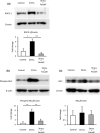Enhancement of the RhoA/Rho kinase pathway is associated with stress-related erectile dysfunction in a restraint water immersion stress model
- PMID: 34676688
- PMCID: PMC8531601
- DOI: 10.14814/phy2.15064
Enhancement of the RhoA/Rho kinase pathway is associated with stress-related erectile dysfunction in a restraint water immersion stress model
Abstract
Stress is a risk factor for erectile dysfunction (ED); however, the pathology of stress-induced ED remains unclear. Accordingly, in this study, we investigated the mechanisms of stress-induced ED using a rat model. Ten-week-old male Wistar/ST rats were maintained in a cage filled with water to a height of 2 cm (stress group) or a normal cage (control group). We found that water immersion stress significantly enhanced the contractile response to noradrenaline in the corpus cavernosum (CC) (p < 0.05). Moreover, stress significantly decreased erectile function, as assessed by changes in intracavernous pressure (p < 0.01). In addition, Rho kinase-1 (ROCK-1) protein expression was significantly upregulated under stress conditions (p < 0.05), and phosphorylated myosin light chain (phospho-MLC) levels, contribute to smooth muscle contraction, were also upregulated (p < 0.01). Treatment with fasudil hydrochloride, a Rho kinase inhibitor, for 5 days significantly improved erectile function (p < 0.01) and normalized ROCK-1 and phospho-MLC levels (p < 0.01). Thus, the RhoA/Rho kinase pathway may be associated with stress-induced ED via contraction of CC. Stress also decreased the smooth muscle/collagen ratio of CC (p < 0.01), and fasudil treatment did not alleviate these effects (p = 0.50). These findings suggested that penile fibrosis gradually progressed under stress conditions and that fibrosis may be independent of the RhoA/Rho kinase pathway, implying that longer exposure to stress may promote ED. We conclude that stress-induced ED was caused by contraction of CC mediated by the RhoA/Rho kinase pathway.
Keywords: RhoA/Rho kinase pathway; contraction; erectile dysfunction; rat; stress.
© 2021 The Authors. Physiological Reports published by Wiley Periodicals LLC on behalf of The Physiological Society and the American Physiological Society.
Conflict of interest statement
The authors have no conflict of interest relevant to this article.
Figures







Similar articles
-
Prenatal exposure to dibutyl phthalate contributes to erectile dysfunction in offspring male rats by activating the RhoA/ROCK signalling pathway.Toxicology. 2024 Nov;508:153925. doi: 10.1016/j.tox.2024.153925. Epub 2024 Aug 14. Toxicology. 2024. PMID: 39151608
-
Angiotensin II Silencing Alleviates Erectile Dysfunction Through Down-Regulating the Rhoa/Rho Kinase Signaling Pathway in Rats with Diabetes Mellitus.Cell Physiol Biochem. 2018;45(1):419-427. doi: 10.1159/000486919. Epub 2018 Jan 22. Cell Physiol Biochem. 2018. PMID: 29402797
-
MicroRNA-141 Inhibits the Proliferation of Penile Cavernous Smooth Muscle Cells Associated with Down-Regulation of the Rhoa/Rho Kinase Signaling Pathway.Cell Physiol Biochem. 2018;48(1):348-360. doi: 10.1159/000491741. Epub 2018 Jul 17. Cell Physiol Biochem. 2018. Retraction in: Cell Physiol Biochem. 2021;55(5):671. doi: 10.33594/000000461. PMID: 30016773 Retracted.
-
Rho-kinase and RGS-containing RhoGEFs as molecular targets for the treatment of erectile dysfunction.Curr Pharm Des. 2005;11(31):4029-40. doi: 10.2174/138161205774913390. Curr Pharm Des. 2005. PMID: 16378508 Review.
-
RhoA/Rho-kinase in erectile tissue: mechanisms of disease and therapeutic insights.Clin Sci (Lond). 2006 Feb;110(2):153-65. doi: 10.1042/CS20050255. Clin Sci (Lond). 2006. PMID: 16411892 Review.
Cited by
-
Efficacy of a Red-Light Controllable Nitric Oxide Releaser for Neurogenic Erectile Dysfunction: A Study Using a Rat Model of Cavernous Nerve Injury.World J Mens Health. 2023 Oct;41(4):909-919. doi: 10.5534/wjmh.220146. Epub 2023 Jan 3. World J Mens Health. 2023. PMID: 36649921 Free PMC article.
-
A review of experimental techniques for erectile function researches and development of medical technology using animal erectile dysfunction models in sexual and reproductive medicine.Reprod Med Biol. 2023 Apr 3;22(1):e12513. doi: 10.1002/rmb2.12513. eCollection 2023 Jan-Dec. Reprod Med Biol. 2023. PMID: 37020643 Free PMC article. Review.
-
Developmental and functional roles of androgen and interactive signals for external genitalia and erectile tissues.Reprod Med Biol. 2024 Oct 6;23(1):e12611. doi: 10.1002/rmb2.12611. eCollection 2024 Jan-Dec. Reprod Med Biol. 2024. PMID: 39372370 Free PMC article. Review.
-
Biodegradable nano black phosphorus based SDF1-α delivery system ameliorates Erectile Dysfunction in a cavernous nerve injury rat model by recruiting endogenous stem/progenitor cells.J Nanobiotechnology. 2023 Dec 18;21(1):487. doi: 10.1186/s12951-023-02238-x. J Nanobiotechnology. 2023. PMID: 38105187 Free PMC article.
-
Plasma hepcidin level is elevated by water immersion-induced central fatigue via hepatic inflammatory response in male and female rats.Physiol Rep. 2025 Aug;13(15):e70468. doi: 10.14814/phy2.70468. Physiol Rep. 2025. PMID: 40757778 Free PMC article.
References
-
- Andersson, K. E. (2001). Pharmacology of penile erection. Pharmacological Reviews, 53, 417–450. - PubMed
-
- Bianca, V. , Mitidieri, E. , Donnarumma, E. , Fusco, F. , Longo, N. , De Rosa, G. , Novellino, E. , Grieco, P. , Mirone, V. , Cirino, G. , & Sorrentino, R. (2015). A new therapeutic approach to erectile dysfunction: Urotensin ‑ II receptor high affinity agonist ligands. Asian Journal of Andrology, 17, 81–85. - PMC - PubMed
MeSH terms
Substances
LinkOut - more resources
Full Text Sources
Medical

